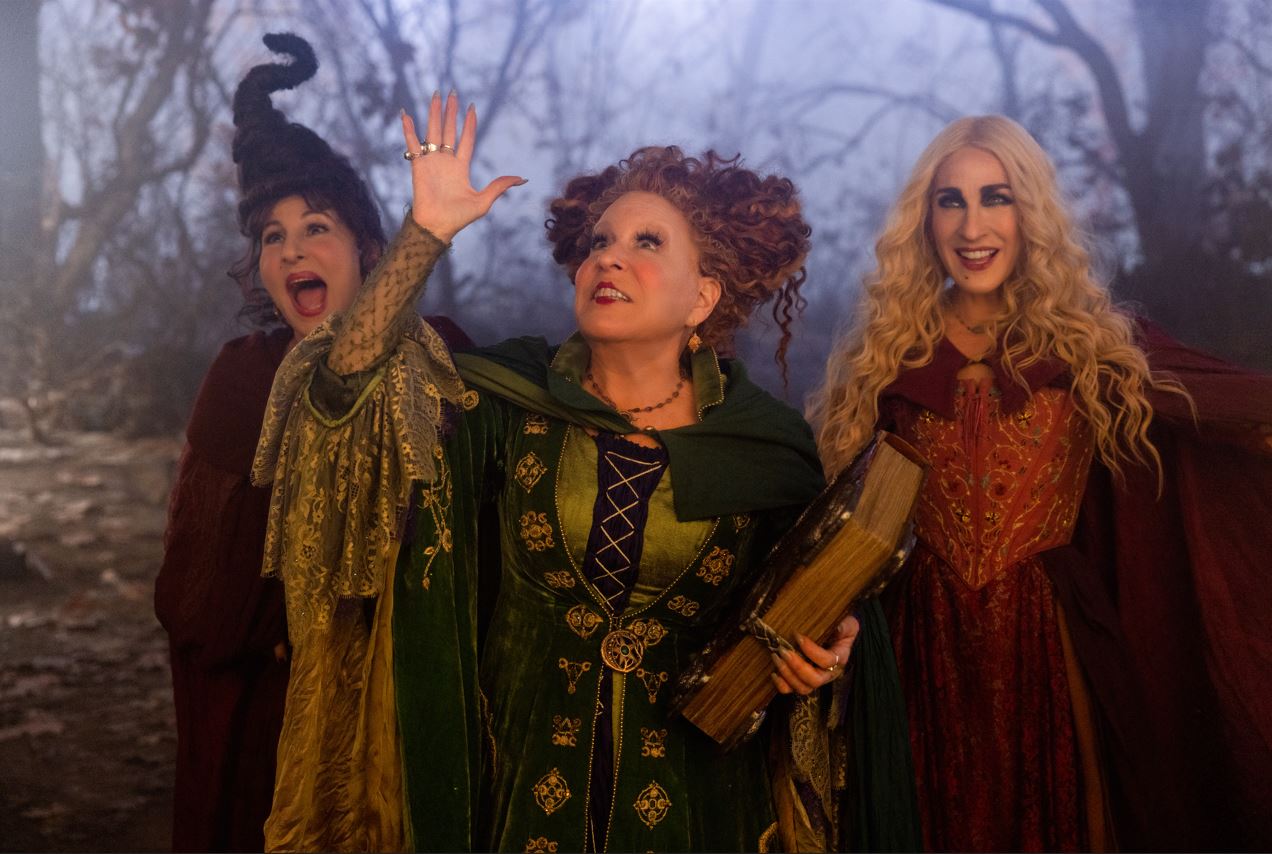‘Hocus Pocus 2’ Proves You Can Have a Story With Persecuted Villains Who Are Still Evil
The witches are back and as wicked as ever!

Disney+’s Hocus Pocus 2 is a delightful throwback to the original story that also manages to do plenty of new things with our favorite coven of witches. But perhaps one of the most unique things about this “re-quel” is the way they stay true to the Sanderson Sisters while also allowing for added depth.
Spoilers for Hocus Pocus 2!
Persecution
Hocus Pocus 2 opens with a flashback to Puritan times, when the Sanderson sisters were just teenage girls, with Winifred almost being forced into marriage and the girls almost being separated by the townsfolk who saw Winnie as a bad influence. I’ll admit, I was a little concerned by this opening, thinking we were going to get a Maleficent-esque retcon for the literal child-murdering Sanderson Sisters.
In reality, the movie flips that on its head when the present-day owner of the Sanderson Sisters’ house/magic shop, Gilbert, believes that because they were persecuted as witches and powerful women by the Puritans, the are actually victims and good people who would be willing to teach him magic. (Which, given the history of Salem and the Witch Trials, is technically closer to the truth than the original movie.) The Sanderson Sisters completely write Gilbert off as a magic user, force him to do their bidding, and frequently threaten, torture, and control others in their quest for ultimate power.
This comments on a larger trend in both Disney and non-Disney villains, where making them part of a persecuted minority means they’re 1) immediately a victim and therefore worthy of redemption and/or 2) completely devoid of characterization beyond their status as a persecuted minority (be it due to single-minded revenge or just a general lack of outside characteristics). Thankfully, neither is the case with the Sandersons.
Even their quest for revenge against the family of the Reverend who almost separated them is more in addition to their personal goals than making it the end-all, be-all. While there can be argument made for how “sins of the father” relate to inherited wealth and influence, Hocus Pocus 2 notably comments on how the Sisters could have gotten revenge on the Reverend himself when they were alive if they wanted, so they’re really just being petty.
Frankly, seeing the Sanderson Sisters stay zany is a refreshing change from many recent live-action Disney villains, many of whom felt toothless or toned down or outright made into heroes in the new movies (compare live-action Jafar with cartoon Jafar). The Sanderson Sisters are still evil, still wicked, and still very fun to watch.
Sympathy for the witches
That doesn’t mean they’re without sympathy, though. When Winnifred completes the spell for ultimate power, it turns out that she neglected to read the fine print about losing what she values most, and thus loses her sisters, an ironic echo of what she had taken from Thackery Binx.
And Winnifred collapses. For all her wickedness and aggravation with her siblings, she can’t stand to continue on without them and begs for the protagonists to help her. When they tell Winnifred they cannot bring the sisters back but can send her to them, Winnie is surprisingly at peace. No more prioritizing youth and beauty, no more fruitless quests for power or vengeance against those long dead. She finally realizes what is most important to her and lets go of everything else.
It’s not a redemption arc per se, since she doesn’t save anyone or apologize/atone for her actions against those she has wronged, but it is a surprising amount of growth for one of the classic Disney villainesses. Even better that it’s entirely in character.
When they first drank away Emily Binx’s life force, Winnie had them join hands and share the youth amongst each other. Also, if Winnie didn’t cast out Sarah for (supposedly) stealing Billy Butcherson away from her, then it stands to reason that she ultimately loved her sisters more than anything else.
Theme resonance
What’s made even better is how it also reflects the protagonists’ friendship back at them. Becca and Izzy, the two girls who accidentally summoned the sisters, are upset with their friend, Cassie, for not prioritizing their friendship. This is a thematic reference to the original, where Dani and Max’s turbulent sibling relationship was contrasted with Thackery’s centuries of mourning for the sister he lost. Only this time, the Sanderson sisters are reflecting these friends’ future to them, should they lose sight of what’s important and part ways.
Ultimately, this movie manages to have its spell and cast it too, giving us more of what we love from Sarah, Mary, and Winnie, while also adding to the complexity of their characters and relationship with each other. Hats off to the actors, writers, and directors for that.
Have a tip we should know? tips@themarysue.com